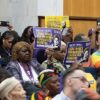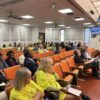November 13, 2018. Lexington Herald Leader.
The city of Lexington took its first step Tuesday toward hiring a group from New York to analyze crime data for the past five years to determine if Lexington has a problem with crimes committed by groups and gangs.
The Lexington-Fayette Urban County Council voting unanimously during a Tuesday work session to approve a $35,000 contract with John Jay College for Criminal Justice’s National Network for Safe Communities. A final vote is expected in December.
An interfaith coalition of leaders has pressed Mayor Jim Gray, police and other city leaders for four years to implement the National Network for Safe Communities model, which uses direct intervention methods in neighborhoods to address group crime activity.
In the past, Lexington officials were hesitant to pursue programs offered by the National Network for Safe Communities because much of Lexington’s crime is not necessarily related to gangs or group crime.
Dozens of people from BUILD, or Building a United Interfaith Lexington through Direct Action, attended Tuesday’s work session to urge the council to approve the contract.
Bryna Reed, a BUILD member, said the National Network for Safe Communities programs are well-regarded throughout the country.
“Business as usual is not going to cut it,” Reed said. “We don’t need to reinvent the wheel.”
Sherry Warsh, who grew up in St. Martin’s Village off of Georgetown Road, said it was a safe place to live when she grew up. Now, it is not, she said.
“The Sunday before Easter, there were two drive by-two shootings,” Warsh said.
Her mother still lives there. “We feel held hostage by violence,” she said.
Lexington Public Safety Commissioner Ken Armstrong said the city is always looking for proven ways to reduce violent crimes, but crime patterns are different in each city.
Armstrong said analysis of crime data done by John Jay College professors is just that — a look at whether Lexington has a group crime problem. If it does, then the study, which will take a maximum of six months to complete, will suggest possible solutions.
The city has not committed to the National Network for Safe Communities model or programs, he said.
“The study will look at if it exists and to what extent it exists,” Armstrong said.
Group crimes and gangs are not the same, said Armstrong, a former assistant police chief.
“There are groups that are not gangs,” he said.
Although the number of murders has climbed in recent years, overall the violent crime rate is “significantly down from year to year,” Armstrong said. Still, an uptick in the number of homicides over time is concerning, he said.
One category of violent crime that has increased significantly is non-fatal shooting, which is up 58 percent since 2011, from 68 shootings to 103 in 2017.
In addition to analyzing data, the group would also talk to citizens and other public officials, Armstrong said.
BUILD has pushed the city to hire the National Network for Safe Communities for years.
The interfaith group has a long history of advocating for social justice reforms in Lexington. It successfully pushed for the creation of the Affordable Housing Trust in 2014 to address the loss of affordable housing in the city.
In a letter to council members, BUILD leaders said it was time to tackle Lexington’s violent crime problem.
“The number of people shot and killed in Lexington has increased over the last few years — from 19 homicides in 2015 to a record-breaking 28 in 2017,” wrote Rev. Andrew Hege and Rev. Joseph Owens, co-chairs of the BUILD coalition.
“This detailed problem analysis is a critical first step in laying the ground work for Lexington to address the violence in the most effective and efficient way possible,” the letter said.
The National Network for Safe Communities model has been implemented in more than 70 cities, which “have had a dramatic and sustained reduction in violent crime,” they wrote.
View original article.






